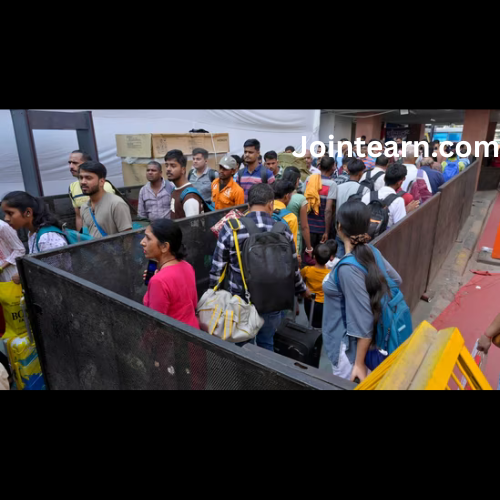
As the air across northern India begins to echo with the sounds of devotional songs and the scent of freshly prepared thekua, the nation gears up for one of its most significant festivals — Chhath Puja. With millions of devotees returning to their hometowns to celebrate, Indian Railways has found itself at the center of this massive human movement, responding with one of the largest logistical exercises of the year. In anticipation of record-breaking crowds during the festive season — coming right after Diwali and coinciding with the Bihar elections — the Railways have launched an unprecedented operation, adding over 12,000 special train trips across the country.
India on the Move: Record Festive Rush
Every year, as Diwali concludes, railway stations across India transform into bustling hubs of energy and emotion. This year, that transformation has been particularly intense. With both Diwali and Chhath Puja falling within days of each other, and millions of people eager to return home for the celebrations, the Railways are witnessing one of the busiest travel seasons in recent memory.
According to officials, passenger movement has surged dramatically, prompting Indian Railways to scale up operations nationwide. The Western Railway alone has introduced nearly 2,000 additional trains, responding to the rising demand for seats and ensuring that no passenger is left stranded.
Western Railway General Manager Vivek Kumar Gupta, who personally inspected arrangements at key stations across Gujarat, said, “We are running trains on demand. I am reviewing all the holding areas prepared for passengers.” The move comes as part of a larger nationwide effort to ensure smoother operations, with stations operating at full capacity round the clock.
Northern Railway Expands Services Amid Bihar Elections
The Northern Railway, which handles some of the densest passenger traffic in the country, has also expanded its services this season. CPRO Himanshu Shekhar Upadhyay noted that the simultaneous Bihar elections have intensified the rush this year. “There is a lot of crowd during Chhath, and this time people are going in greater numbers,” he said.
Last year, Northern Railway ran 3,800 special trains during the festive season. This year, that number has climbed to over 4,800, a sharp increase reflecting both higher demand and improved logistical capacity. Nationally, the figure of special trains has jumped from 9,000 last year to more than 12,000 this year, underscoring the scale of preparation undertaken by Indian Railways.
In addition to adding trains, the Railways have set up mini control rooms at major stations to monitor crowd movements, coordinate arrivals and departures, and manage emergency situations. Staff deployment has been doubled in several high-traffic zones like Delhi, Patna, Lucknow, and Varanasi to maintain order amid the massive rush.
Stations Turn into Sites of Festive Joy
Beyond logistics, the Indian Railways have also sought to infuse a touch of cultural warmth into the travel experience. Beginning Friday, railway stations across the country began broadcasting Chhath devotional songs, transforming these typically chaotic spaces into centers of celebration.
The Railway Ministry stated that the initiative was designed to “connect passengers with the spirit of the festival and make their journeys more pleasant.” A ministry press release noted that “these devotional songs being played at railway stations during Chhath Puja are creating a sacred atmosphere for the devotees.”
At 30 major stations — including Patna, Danapur, Hajipur, Bhagalpur, Jamalpur, Sonpur, New Delhi, Ghaziabad, and Anand Vihar Terminal — the sounds of traditional Chhath songs have filled the air. For passengers heading home, these melodies serve as a comforting reminder of their roots and culture, evoking nostalgia even before they arrive at their destinations.
Delhi Gears Up for a Grand Celebration
While trains crisscross the nation to bring devotees home, Delhi is making its own elaborate preparations for the upcoming Chhath Puja. The festival has grown immensely in popularity in the capital over the past decade, drawing massive gatherings along the Yamuna’s banks.
Delhi Minister Kapil Mishra, who inspected arrangements at the Sonia Vihar ghat, said, “There are 17 big ghats on the Yamuna, one of which is the Sonia Vihar ghat. Arrangements are in place from Palla to Kalindi Kunj. The Chief Minister herself is leading these preparations. This time, a spectacular Chhath will be organised in Delhi.”
Special cleaning drives, barricades, lighting, water supply, and safety measures are being arranged at ghats to accommodate the expected crowds. The Delhi government has also coordinated with local police and disaster management authorities to ensure a safe and smooth celebration.
The Spirit and Significance of Chhath Puja
Chhath Puja, one of the most ancient Hindu festivals, is dedicated to the worship of the Sun God (Surya) and Chhathi Maiya, the goddess believed to be the consort of Surya. The festival is a profound expression of gratitude for life, light, and nature’s bounty, celebrating the cyclical relationship between humans and the environment.
This year, Chhath will be celebrated from October 25 to 28, marking four days of deeply symbolic rituals. The first day, Nahay-Khay, involves devotees bathing in holy water and preparing a single vegetarian meal cooked in purity. The second day, Kharna, is a fasting day that culminates with a simple meal of jaggery kheer, fruits, and rice pudding.
The following day, devotees offer the “Sanjh Arghya” — evening prayers to the setting sun — while standing waist-deep in rivers or ponds, thanking Surya for sustaining life. The final day, known as Usha Arghya, is the morning offering to the rising sun, symbolizing hope, renewal, and gratitude.
Throughout these days, devotees observe rigorous fasts, often abstaining even from water, and perform prayers barefoot, reflecting devotion, endurance, and purity.
Celebration Across Regions and Borders
Chhath Puja is celebrated most prominently in Bihar, Jharkhand, Uttar Pradesh, and parts of Nepal, though its reach now extends far beyond. Cities like Delhi, Mumbai, Kolkata, and even international hubs like Dubai, London, and New York witness large gatherings of the diaspora observing the festival with the same devotion.
Traditional folk songs, handmade prasad like thekua, and the sight of thousands of devotees offering arghya along the riverbanks create an atmosphere of shared faith and cultural unity.
The Human and Logistical Miracle
Behind this vast celebration lies a remarkable logistical undertaking — not just by devotees but by the Indian Railways and local administrations who ensure that the nation’s great migration unfolds with minimal disruption. From special trains and extended station facilities to cultural broadcasts and safety arrangements, the Railways’ efforts this year reflect both operational efficiency and cultural sensitivity.
As the country readies itself for Chhath, trains packed with passengers continue to roll through the night — filled with songs, laughter, and the anticipation of reunion. At every stop, from the crowded platforms of Delhi to the riverbank ghats of Bihar, the festival’s essence shines through: a celebration of faith, family, and the enduring rhythm of life that unites millions across India.
In the words of an elderly traveler at Patna Junction, “No matter how far we go, Chhath brings us home.”


Leave a Reply